Nearly three months ago, Toronto’s Contact Photography Festival commenced, announcing identity as its thematic focus. Fortunately some of Contact’s exhibitions are ongoing into the depths of the summer months. Specifically, BAND (Black Artists’ Networks in Dialogue) Gallery’s captivating exhibition Gordon Park. BAND’s inaugural exhibition successfully probes the festival’s central theme through its methodical exploration of one of the most celebrated figures of 20th century photography.
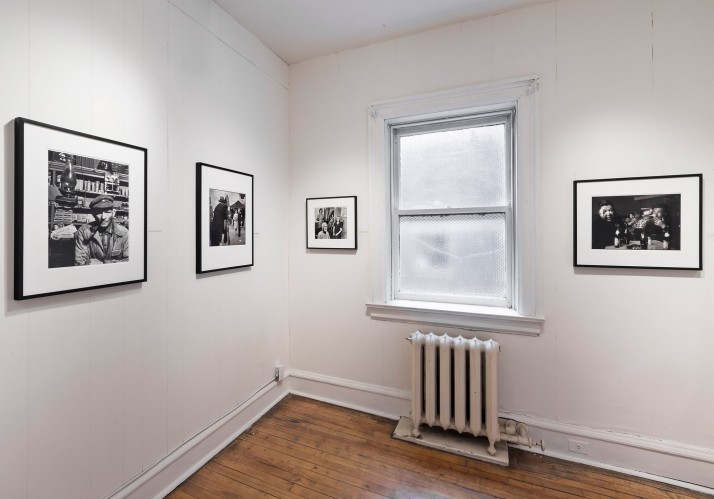 Installation view of, Gordon Parks: Portraits, © Toni Hafkenscheid
Installation view of, Gordon Parks: Portraits, © Toni Hafkenscheid
BAND’s new space in a converted Victorian apartment houses forty-two of Parks’ portraits spanning over the three decades (1940- 1970) of his long and revolutionary career. Utilizing the apartment’s preexisting room divisions, the photographs on display are organized thematically in various rooms to feature Parks’ thematic and stylistic range as a photographer.
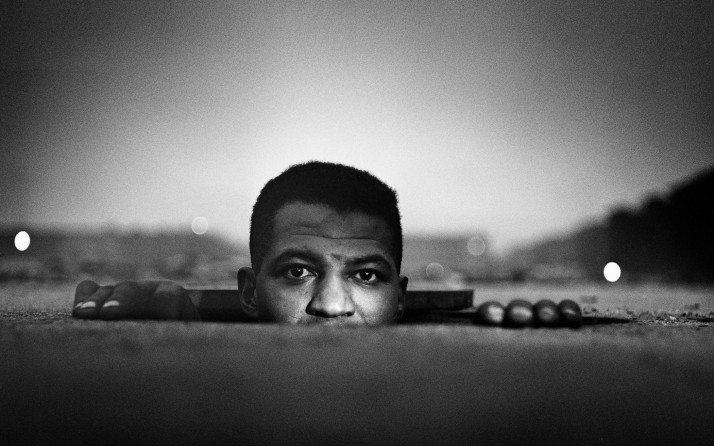 Gordon Parks, Emerging Man, Harlem, New York, 1952, Copyright The Gordon Parks Foundation. Courtesy The Gordon Parks Foundation.
Gordon Parks, Emerging Man, Harlem, New York, 1952, Copyright The Gordon Parks Foundation. Courtesy The Gordon Parks Foundation.
It is both quite appropriate and ironic that Parks’ work is showcased for its exploration of identity since he was an artistic chameleon. Scholars proclaim that labeling Parks as a photographer is limiting; as he was also a poet, composer, author, filmmaker, and painter. Even as a photographer he explored various genres ranging from fashion to social documentary photography. However, rather than grappling with Parks’ dynamic creative persona, the portraits in this exhibition demonstrate the ways in which Parks’ many artistic identities influenced his photographic style and interests.
As an African American man living during one of the darkest periods of American history, Parks employed photography in order to highlight the reality of racism to all Americans. Parks’ social documentary work for LIFE magazine can be likened to the photographs produced by American sociologist and photographer Lewis Hine, who also employed his camera as a “weapon” to promote social reform for child labour legislation. Parks’ photographs expose injustice and impoverishment. Observers of his works are left to wonder how he captured these images during a period when he himself was a victim of such racism. Yet, his photographs of ugly racist discourse also reflect a particular delicate and intimate beauty, which stimulates awe and compassion without trivializing the subject matter.
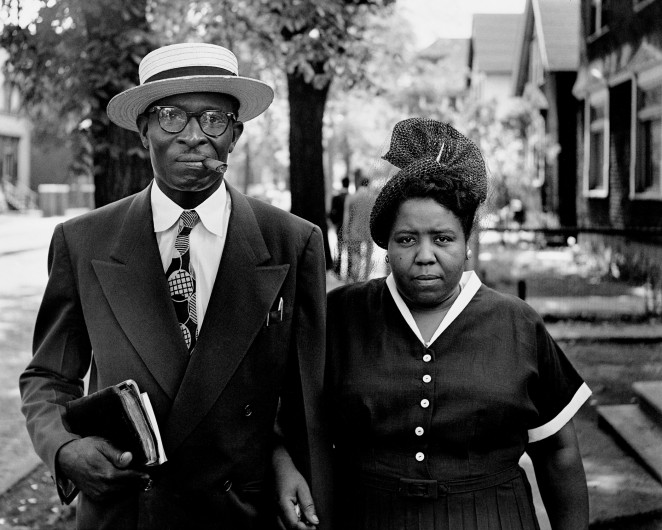 Gordon Parks, Husband and Wife on Sunday Morning, Fort Scott, Kansas, 1949, Copyright The Gordon Parks Foundation. Courtesy The Gordon Parks Foundation.
Gordon Parks, Husband and Wife on Sunday Morning, Fort Scott, Kansas, 1949, Copyright The Gordon Parks Foundation. Courtesy The Gordon Parks Foundation.
Parks also photographed celebrities. Interestingly, he managed to capture the ‘known’ fortunate figures with the same respect and intimacy echoed in his LIFE photography. This is evident particularly in his portrait of Ingrid Bergman, taken in 1950, during a period of tremendous turmoil in the actress’ life following the discovery of her affair with director Roberto Rossellini. Here Parks’ brilliant capacity for symbolism as a poet shines through as he captures Bergman in a moment of vulnerability, as the clocked figures in the background gaze menacingly in her direction, as though the source of psychological torment.
His multifaceted artistic talents are again evident in his photograph of Ethel Shariff, the leader of the women’s corps of the Black Muslims and daughter of Elijah Muhammad. The photograph is aesthetically astounding, due to its geometric repetition and triangular composition. Aside from its aesthetic merits, the configuration also articulated the rigid systematic order and unity inherent to the Muslim brotherhood as well as Shariff’s role at the apex of the ‘pyramid’ of such a system.
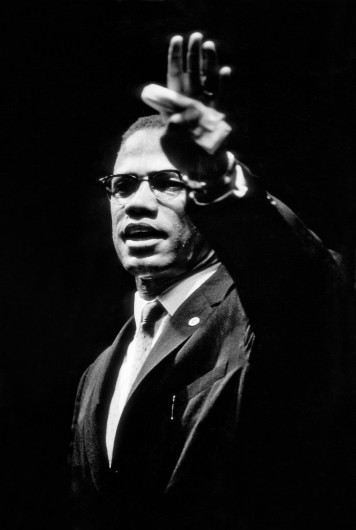 Gordon Parks, Malcolm X at Rally, Chicago, Illinois, 1963, Copyright The Gordon Parks Foundation. Courtesy The Gordon Parks Foundation.
Gordon Parks, Malcolm X at Rally, Chicago, Illinois, 1963, Copyright The Gordon Parks Foundation. Courtesy The Gordon Parks Foundation.
While the exhibit utilizes limited wall text, it is a rather fitting choice, as it enables the visitor to engage with the photographs in a more organic manner. Wall text is limited to a brief introduction at the exhibition’s beginning and the wall labels that accompany each photograph. This permits the viewer to construct his or her own narrative of Parks’ work. The gallery trusts the visitors to think through the photographs’ themes independently, creating an engaging, cognitive experience. This is an approach with Parks himself employed as a photographer. In the documentary Half Past Autumn, which plays in the final exhibition room, Parks explains how he uses photography as a medium, keeping with the advice of his mentor and leader of the famous Farm Security Association (of which Park was its first black member) Roy Stryker. According to Parks, Stryker taught him that photography, as a medium for social change, could be misused if utilized to simply take a photograph of a bigot and label it as such. Instead a photograph’s power as a social weapon was attributed to its ability to reveal the root of bigotry and discrimination itself.
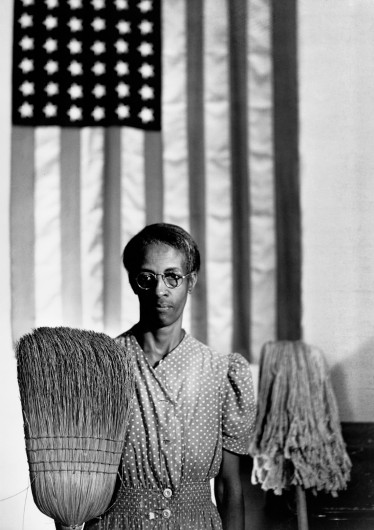 Gordon Parks, American Gothic, Washington, D.C., 1942, Copyright The Gordon Parks Foundation. Courtesy The Gordon Parks Foundation
Gordon Parks, American Gothic, Washington, D.C., 1942, Copyright The Gordon Parks Foundation. Courtesy The Gordon Parks Foundation
The staff at BAND are incredibly friendly and willing to offer their extensive knowledge on Parks’ work, and are eager to provide additional information. The documentary film at the conclusion of the exhibit is a much-appreciated inclusion, as it offers more information and perhaps answers to some of the questions that result from viewing the photographs. The exhibition celebrates Parks’ achievements as a dynamic photographer with an incredible range in subject; from those who experienced severe marginalization and cruelty to those who were celebrated and acclaimed in the canon of great 20th century icons. His work explores the lived experiences of a multitude of individuals, exposing their realties, identities, and humanizing them. BAND’s exhibition further implores the visitor to reflect on the complex identity of the photographer himself and the dimension this brings to the works. Hopefully, the exhibit further allows the visitor to engage with their own concept of identity.
Melina Rymberg
*Exhibition information: April 25 – September 28, 2014, BAND Gallery, 1 Lansdowne Ave 2nd Fl. Gallery hours: Wed – Fri 11 – 6, Sat 12 – 6, Sun 1 –5 p.m.
